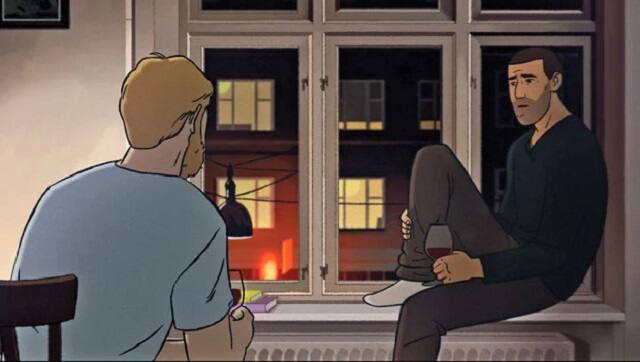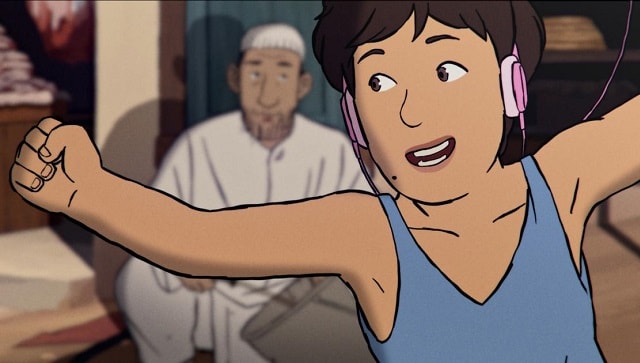What does it mean to tell a story? Is it about asking the difficult questions or is it about developing a distinct cinematic language that makes the questions worthwhile? In Flee
, the Oscar-nominated documentary that tells the harrowing story of one man’s escape from war-torn Kabul in the 80s, Jonas Poher Rasmussen seamlessly balances both these asks. The setup is simple: a filmmaker interviews a childhood friend who starts recalling the horrors that he and his family endured when they fled Afghanistan for Moscow and beyond. But it’s also made audacious by the fact that nobody knows his story — even the Danish filmmaker learns about it years into their friendship. Rasmussen, keenly aware of the stakes, looks at the larger picture, settling on a form of storytelling that doesn’t sacrifice his friend’s anonymity while also ensuring that the personal chords resonate universally. In that sense, Flee, which earned three Oscar nods earlier this year for Best Animated Feature, Best International Film, and Best Documentary Feature, becomes the kind of story that tells multiple stories. In confronting the traumas that he fled from for most of his life, Rasmussen’s friend — known in the film as Amin Nawabi — ends up accommodating the inhumane realities of refugees, their lives as much in crisis three decades later. On his part, Rasmussen lends Amin a cinematic canvas — an arresting mix of hand-drawn animation, archival footage, vivid flashbacks, and conversational voiceovers — that make the refugee narrative at the center of Flee both emotionally involving and immersive. It’s a tall order simply because we never quite “see” Amin over the course of the film’s 89-minute runtime. Flee withholds Amin’s real identity, including his face (In the English version, Amin is voiced by executive producer Riz Ahmed). Not only because Amin gained asylum in the country by presenting himself as an orphaned, teen refugee who arrived at Copenhagen airport after making a solo escape from Afghanistan. But also because he is gay. Amin’s religion doesn’t recognize his queerness and much of his childhood was spent in suppressing his inner desires. [caption id=“attachment_10660701” align=“alignnone” width=“640”] A still from Flee[/caption] Today, Amin is a middle-aged academic living with his fiance in Denmark as an openly gay man — a life that he never imagined could be possible and one that is possible only after he was granted asylum in Denmark. It’s perhaps why the constant threat of being deported back to Afghanistan colours so much of his present. Even though Amin built a whole new life — from scratch — in Denmark, he never really allowed himself to start over. Over the years, he kept holding back — his own history and the whereabouts of his family (all of whom are alive and scattered across Europe) remained a secret from everyone, including his partner Kasper. In fact, when we meet Amin for the first time in Flee, he’s struggling to commit to the idea of building a home together with Kasper in an idyllic countryside. The truth is that Amin’s life — both as an immigrant and as a gay man — involved so much displacement and suppression that it fractured his identity and more importantly, sullied his sense of belonging. Even when he is seemingly free, Amin remains in exile, at a far remove from even his closed ones.
A still from Flee[/caption] Today, Amin is a middle-aged academic living with his fiance in Denmark as an openly gay man — a life that he never imagined could be possible and one that is possible only after he was granted asylum in Denmark. It’s perhaps why the constant threat of being deported back to Afghanistan colours so much of his present. Even though Amin built a whole new life — from scratch — in Denmark, he never really allowed himself to start over. Over the years, he kept holding back — his own history and the whereabouts of his family (all of whom are alive and scattered across Europe) remained a secret from everyone, including his partner Kasper. In fact, when we meet Amin for the first time in Flee, he’s struggling to commit to the idea of building a home together with Kasper in an idyllic countryside. The truth is that Amin’s life — both as an immigrant and as a gay man — involved so much displacement and suppression that it fractured his identity and more importantly, sullied his sense of belonging. Even when he is seemingly free, Amin remains in exile, at a far remove from even his closed ones.
Flee is constructed in a manner that it soon stops mattering that we don’t get to see Amin — for we get to know him as intimately as it is possible to know another human being. Amin’s openness is a product of the animated format of the film, allowing him to be candid and truthful about his history without any fear. His memories are stacked with the kind of details that translate into moving poetry on screen — whether it is images of a young Amin running around in the packed, colourful streets of Kabul or a teen Amin longingly gazing at posters of Jean-Claude Van Damme. Even the informal, unhurried tone of the voiceover (filmed as a back-and-forth interview between Rasmussen and Amin) doesn’t merely feel like words being read aloud from a script. Instead, they’re infused with feeling — confusion, regret, and loneliness are accommodated within pauses, chuckles, stutters, and unsteady inflections. Afterall, his memories aren’t just words; they condense an entire lifetime of suffering, survival, and resilience. Indeed, it’s the unflinching, staggering clarity of Flee’s cinematic language that allows us to see Amin this clearly. In the film, Amin’s story shifts timelines a few times — fearful encounters with corrupt Russian cops are relived in tandem with memories of Amin knowing and hiding his homosexuality while growing up in Kabul, stacked next to nightmarish scenes of human trafficking (one standout, suffocating scene mid-sea is so moving that it rankles). Time and again, Rasmussen adeptly conjures moments of unbelievable suspense, especially when Amin and his family are at the mercy of corrupt traffickers and officials. All of it nicely contrasts with the unhurried rhythm that lets Amin discover so much of himself through his recollections of his own life as it helps viewers in empathizing with his decades-long silence.
The compassionate language of the filmmaking — so devastating yet nuanced in its indictment — succeeds in pulling viewers even closer to Amin.
Still, Flee eschews employing the horrors of displacement as a phase of life in Amin’s narrative. Instead, it primes it as the consequence of demanding a life — focusing on the scars left behind by those terrifying years of uncertainty. For instance, Rasmussen keenly underlines the extent of Amin’s repression — how he sees his own future as a debt he owes to his family who sacrificed everything they could to give him a life of safety. In that, he almost trained himself to believe that his personal happiness was an act of betrayal against his family. It’s the story that Amin has been telling himself through his adult life, a cycle that he realises he should break after voicing his story in his own words for the first time. [caption id=“attachment_10660721” align=“alignnone” width=“640”] A still from Flee[/caption] In laying the foundation for Amin’s unburdening, Flee becomes a bold and remarkable restoration of dignity of life. That’s also because Rasmussen builds Flee as a loving tribute to the undying spirit of his friend. In doing so, he quietly expands the boundaries of documentary storytelling, treating it as an evocative medium instead of a mechanical language — one that is capable of humanising injustice while retaining its complexity. It’s as if Flee understands one thing: the point of any story is to do justice to it. Flee is available on ZEE5
A still from Flee[/caption] In laying the foundation for Amin’s unburdening, Flee becomes a bold and remarkable restoration of dignity of life. That’s also because Rasmussen builds Flee as a loving tribute to the undying spirit of his friend. In doing so, he quietly expands the boundaries of documentary storytelling, treating it as an evocative medium instead of a mechanical language — one that is capable of humanising injustice while retaining its complexity. It’s as if Flee understands one thing: the point of any story is to do justice to it. Flee is available on ZEE5
Poulomi Das is a film and culture writer, critic, and programmer. Follow more of her writing on Twitter . Read all the Latest News , Trending News , Cricket News , Bollywood News , India News and Entertainment News here. Follow us on Facebook , Twitter and Instagram .
)